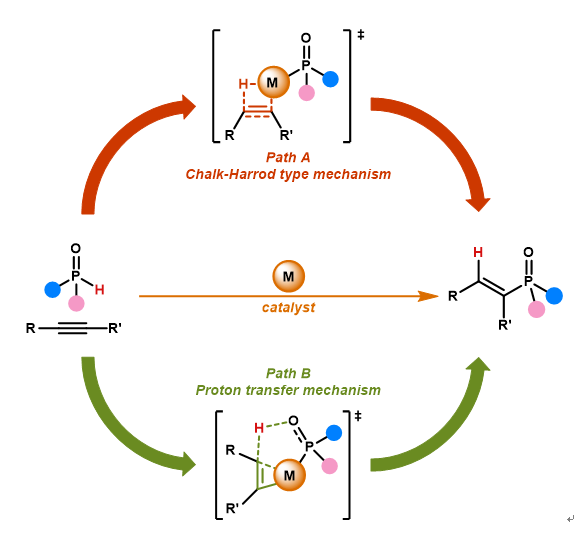[1](a) Guo H.; Fan Y. C.; Sun Z.; Wu Y.; Kwon O. Chem. Rev.2018, 118, 10049-10293.
(b) Ni H.; Chan W.-L.; Lu Y. Chem. Rev.2018, 118, 9344-9411.
(c) Liu X., Wu Y., Zhang Q. Synlett2022, 33, 301-306.
(d) Banerjee I, Panda TK. Org Biomol Chem.2021, 19(30), 6571-6587.
(e) B. T. Novas, R. Waterman, ChemCatChem.2022, 14, e20220098.
[2]Han, L.-B.; Tanaka, M.,J. Am. Chem. Soc. 1996, 118 (6), 1571-1572.
[3]Han, L.-B.; Choi, N.; Tanaka, M.,Organometallics 1996, 15 (15), 3259-3261.
[4]Han L.-B.; Mirzaei F.; Zhao C.-Q.; Tanaka, M., J. Am. Chem. Soc.2000, 122 (22), 5407-5408.
[5]Zhao, C.-Q.; Han, L.-B.; Tanaka, M.,Organometallics 2000, 19 (21), 4196-4198.
[6]Dobashi, N.; Fuse, K.; Hoshino, T.; Kanada, J.; Kashiwabara, T.; Kobata, C.; Nune, S. K.; Tanaka, M.,Tetrahedron Lett. 2007, 48 (27), 4669-4673.
[7]Zhao, C.-Q.; Han, L.-B.; Goto, M.; Tanaka, M.,Angew Chem Int Ed. 2001, 40 (10), 1929-1932.
[8]Han, L.-B.; Zhao, C.-Q.; Tanaka, M.,J. Org. Chem. 2001, 66 (17), 5929-5932.
[9]Han L.-B.; Zhang C.; Yazawa H.; Shimada, S., J. Am. Chem. Soc.2004, 126 (16), 5080-5081.
[10]Khemchyan, L. L.; Ivanova, J. V.; Zalesskiy, S. S.; Ananikov, V. P.; Beletskaya, I. P.; Starikova, Z. A.,Adv. Synth. Catal. 2014, 356 (4), 771-780.
[11]Zhang, Y.-Q.; Han, X.-Y.; Wu, Y.; Qi, P.-J.; Zhang, Q.; Zhang, Q.-W.,Chem. Sci. 2022, 13 (14), 4095-4102.
[12]Yang, S.-N.; Sun, S.-H.; Liu, C.-H.; Min, X.-T.; Wan, B.; Ji, D.-W.; Chen, Q.-A.,Chin. Chem. Lett. 2023, 34 (6), 107914.
[13]Qian, D.-W.; Yang, J.; Wang, G.-W.; Yang, S.-D.,J. Org. Chem. 2023, 88 (6), 3539-3554.
[14]Niu, M.; Fu, H.; Jiang, Y.; Zhao, Y., Chem. Commun. 2007, (3), 272-274.
[15]Liu, L. L.; Wu, Y.; Wang, Z.; Zhu, J.; Zhao, Y.,J. Org. Chem. 2014, 79 (15), 6816-6822.
[16]Li, J.; Gao, Z.; Guo, Y.; Liu, H.; Zhao, P.; Bi, X.; Shi, E.; Xiao, J.,RSC Adv. 2022, 12 (29), 18889-18896.
[17]Wu, Z.-H.; Cheng, A.-Q.; Yuan, M.; Zhao, Y.-X.; Yang, H.-L.; Wei, L.-H.; Wang, H.-Y.; Wang, T.; Zhang, Z.; Duan, W.-L.,Angew Chem Int Ed. 2021, 60 (52), 27241-27246.
[18]Nie S.-Z.; Davison R. T.; Dong, V. M., J. Am. Chem. Soc.2018, 140 (48), 16450-16454.
[19]Yang, Z.; Wang, J.,Angew Chem Int Ed. 2021, 60 (52), 27288-27292.
[20]Zhou, J.; Meng, L.; Lin, S.; Cai, B.; Wang, J.,Angew Chem Int Ed. 2023, 62 (26), e202303727.
[21]Long, J.; Li, Y.; Zhao, W.; Yin, G.,Chem. Sci. 2022, 13 (5), 1390-1397.
[22]Han L.-B.; Zhao C.-Q.; Onozawa S.-y.; Goto M.; Tanaka, M., J. Am. Chem. Soc.2002, 124 (15), 3842-3843.
[23]Dai, Q.; Liu, L.; Qian, Y.; Li, W.; Zhang, J.,Angew Chem Int Ed. 2020, 59 (46), 20645-20650.
[24]Yang, Z.; Gu, X.; Han, L.-B.; Wang, J.,Chem. Sci. 2020, 11 (28), 7451-7455.
[25](a) Xu Q.; Han, L.-B., J. Organomet. Chem.2011, 696 (1), 130-140.
(b) Ding, K.; Su, B.,Eur. J. Org. Chem. 2024, 27 (4), e202301160.
[26](a) Rosenberg, L. ACS Catal. 2013, 3 (12), 2845-2855.
(b) Lecerclé D.; Sawicki M.; Taran, F. Org. Lett.2006, 8 (19), 4283-4285.
[27](a) Glueck, D. S. Top. Organomet. Chem.2010, 31, 65-100.
(b) V.Koshti, S. Gaikwad, S. H.Chikkali, Coord.Chem.Rev.2014, 265, 52-73.
(c) C. A. Bange, R. Waterman, Chem. Eur. J. 2016, 22, 12598.
(d) Samantha Lau, Thomas M. Hood, and Ruth L. Webster, ACS Catal. 2022, 12 (17), 10939-10949.
[28]Chen T.; Zhao C.-Q.; Han, L.-B., J. Am. Chem. Soc.2018, 140 (8), 3139-3155.
[29]Liu, S.-Y.; Li, Z.-M.; Guo, H.; Zhang, J.-L.,Eur. J. Org. Chem. 2023, 26 (44), e202300804.
[30]Chen T, Han L-B. Heteroatom Chem. 2018, 29, e21460.
[31]Glueck, D. S. J. Org. Chem.2020, 85, 14276-14285.
[32]Han, L.-B.; Hua, R.; Tanaka, M.,Angew Chem Int Ed. 1998, 37 (1-2), 94-96.
[33]Shen R.; Chen T.; Zhao Y.; Qiu R.; Zhou Y.; Yin S.; Wang X.; Goto M.; Han, L.-B. J. Am. Chem. Soc.2011, 133, 17037.
[34]Jiang, Y.-Y.; Fan, X.; Li, Y.; Ji, G.-C.; Liu, P.; Bi, S.,J. Org. Chem. 2022, 87 (21), 14673-14684.
[35]Chen T, Liu L, Huang T, Han L.-B. Chin. J. Org. Chem., 2019, 39 (8), 2183-2187.
[36](a) J. Gu, C. Cai, Org. Biomol. Chem. 2017, 15, 4226-4230.
(b) X. Chen, X. Chen, X. Li, C. Qu, L. Qu, W. Bi, K. Sun, Y. Zhao, Tetrahedron.2017, 73, 2439-2446.
(c) Liu WQ, Lei T, Zhou S, et al. J. Am. Chem. Soc.2019, 141, 13941-7.
[37](a) Wang H, Li Y, Tang Z, et al. ACS Catal.2018, 8, 10599-605.
(b) H. Hou, J. Wang, X. Chen, Y. Han, H. Yu, C. Yan, Y. Shi, S. Zhu, ChemCatChem.2022, 14, e202201073.
[38]Yoo W, Kobayashi S., Green Chem. 2013, 15, 1844.
[39](a) Jin S, Sun S, Yu JT, Cheng J., J. Org. Chem. 2019, 84, 11177-85.
(b) Hou H, Xu Y, Yang H, et al., Org. Lett. 2020, 22, 1748-53.
[40]X. Chen, X. Li, X. Chen, L. Qu, J. Chen, K. Sun, Z. Liu, W. Bi, Y. Xia, H. Wua,Y. Zhao, Chem. Commun. 2015, 51, 3846-3849.
[41](a) Liu J, Xiao HZ, Fu Q, Yu DG. Chem. Synth. 2021, 1, 9.
(b) Y. Yuan, C. Darcel, ChemCatChem. 2024, e202400703. |
